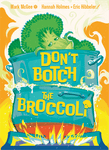Given how much I liked designer Mark McGee‘s first release through his company How to Steam Broccoli — Tether, which I had backed during crowdfunding — when McGee offered a review copy of his second title ahead of its debut at PAX Unplugged 2025, I said, sure, let’s give it a go.
On the surface, Don’t Botch the Broccoli has nothing in common with Tether aside from both being card games, but in practice both designs encourage you to bait opponents, then hope they’ll make the move you want them to make.
Don’t Botch the Broccoli falls into that love/hate genre of simultaneous-play card games, that is, everyone selects a card in hand, then reveals them at the same time: “I think that you think that I’m going to play this card, so you’ll play that card in anticipation, so I’ll instead play this other thing.” You know the drill.
Alex Randolph‘s Raj is the Platonic ideal in this genre, with everyone having the same set of cards in hand and trying to out-think others by not playing the same card as anyone else because then your play is negated. You all start on the same footing due to identical hands, but with each turn that passes, everyone loses a card. By tracking who has played what, you’ll possibly have an edge in future turns, although your success often comes down to good guesses and luck.
Image: Mark McGeeDon’t Botch the Broccoli also gives players an identical hand of cards — two copies each of broccoli valued -1, 1, 2, 3, and 4 — but now you want to match other players…at least some of the time. When you reveal the same card as someone else, each of you places your broccoli in your “steamer”. Essentially, you’re thinking along the lines of another chef while prepping your dish and are like, yes, we’re doing this correctly.
After all matches head to their respective steamers, the chef with the lowest card on the table scores that card, along with all cards in their steamer. Anyone else with a card on the table returns that card to their hand, along with all cards in their steamer. One chef has jumped to move their broccoli onto plates headed to patrons, while the others have waited too long, botching their broccoli and needing to start again.
Thus, you want to think like opponents just enough to load up your steamer, then you want to scoop them on the plating so that customers pay your checks instead of theirs.
Once a chef has scored seven cards or has no cards in hand, the game ends, then everyone scores their served broccoli to see who has done the best.
With only ten cards in hand, your game will run 5-10 minutes, and as in Raj, your success often comes down to good guesses and luck. Maybe you’ll match with someone else and each load your steamer with a 4, then you switch to -1 to try to score it — but they did the same! Do you -1 again, now scoring only 2 points, or do you go higher and hope to match someone else so that you can -1 later?
I’ve played Don’t Botch the Broccoli five times, three times with three players and twice with four, and you can’t plan much about your play — but I don’t think this design is intended to be a “planning” game. Race for the Galaxy has players reveal their action choices simultaneously, but your tableau of cards gives opponents more information about why you’d choose one card over another, and you choose from five actions that are more consequential than choosing a number.
Like Raj, 6 nimmt!, Diamant, and other games with simultaneous play, Don’t Botch the Broccoli mimics a lottery in that you make a choice, then see how things play out. You can’t control what others do; only guess what they’ll do based on who they are and how they’ve played in the past.
Like those other designs, Don’t Botch the Broccoli isn’t about a single play but about subsequent plays, ideally with the same people one after another. You’re hoping to bluff someone not only with this one choice, but with the history of other choices they’ve seen you make. You’re not rewarded for making a smart play, but for making the ideal play — even if you didn’t know it was ideal when you made it.
Some players don’t like this style of game, and others love it, including one person in my four-player games, who wanted a copy immediately. Luckily, McGee had a spare copy on him I could buy as a gift before that person moved out of the area. Ideally she’ll introduce the game to others and spread the love for how to steam broccoli.
For more examples of gameplay and thoughts on the design, watch this video:

/pic8996628.png)
/pic9195657.jpg)
/pic1515479.jpg)
/pic5261714.jpg)



